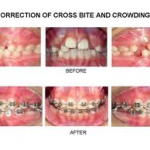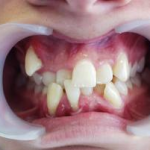Just like baseball and gymnastics are types of sports, an orthodontist (say: or-thoh-don-tist) is a type of dentist. Using braces, retainers, and other devices, an orthodontist helps straighten a person’s teeth and correct the way the jaws line up.
Straight teeth and aligned jaws create nice smiles. On top of that, when your jaws and teeth are well aligned, it is easier to chew food. Orthodontic care can even help prevent snoring!
So why would you go to the orthodontist? Your dentist or one of your parents might recommend it because they see a problem with your teeth or jaws. Or a kid who does not like the way his or her teeth look might ask to see an orthodontist.
Orthodontists treat kids for many problems, including having crowded or overlapping teeth or having problems with jaw growth and tooth development. These tooth and jaw problems may be caused by tooth decay, losing baby teeth too soon, accidents, or habits like thumb sucking. These problems also can be genetic or inherited, meaning that they run in a person’s family.
When Should a Kid Go to the Orthodontist?
There is no set age for a kid to visit the orthodontist — some kids go when they are 6, some kids go when they are 10, and some go while they are teens. Even adults visit the orthodontist for treatment. Many orthodontists say a kid should see an orthodontist before age 7 so any problems can be spotted early. That does not mean a kid will get braces right away. But the orthodontist will know which problems exist and can choose the best time to start treatment. Early detection and treatment of these problems prevent more serious problems from developing later on. When orthodontic treatment is initiated early in childhood there are many advantages, such as:
- Preventing more complicated orthodontic problems from occurring
- Taking advantage of growth at the right time which is essential for success of treatment
- Reducing the possibility of permanent teeth needing to be removed
- Stopping harmful habits such as thumb sucking and tongue thrusting
- The rewards of a corrected smile pay off in improved self esteem
What Happens at the Orthodontist?
When you make your first trip to the orthodontist, you will visit an office that looks a lot like your dentist’s office. You will sit in a dentist chair and the orthodontic technician or assistant might take X-rays or computer pictures of your mouth and teeth. The X-rays and pictures show the orthodontist where the teeth are positioned and whether you have teeth that have not come in yet.
The technician also may make a mold (or impression) of your teeth by pressing a tray of gooey material into your top and bottom teeth. When the mold is removed, there will be a perfect impression of the shape and size of your teeth. A mold helps the orthodontist decide how to straighten your teeth.
The orthodontist will examine your teeth, mouth, and jaws. He or she may ask you to open wide or bite your teeth together and might ask questions about whether you have problems chewing or swallowing or whether your jaws ever click or pop when you open your mouth. The orthodontist may tell you and your parent that your teeth and jaws are fine, or recommend that you begin treatment.
What happens if I am ready to start treatment?
The orthodontist will explain:
1. The options for treatment and which is the best for you.
2. The pros and cons of treatment.
3. The length of time the treatment will take.
4. The commitment needed on your part if treatment is to be successful.
5. When you can expect the treatment to begin.
 At this point you will be given the chance to ask any questions. If you would like to go ahead with the treatment, the orthodontist may ask for written consent.
At this point you will be given the chance to ask any questions. If you would like to go ahead with the treatment, the orthodontist may ask for written consent.
When will treatment start?
This will depend on:
1. How many of your adult teeth have come through. Many treatments are best left until the adult teeth have replaced the first teeth.
2. Problems with toothbrushing or tooth decay which may have to be dealt with.
3. The length of any waiting list for the particular orthodontic treatment you need.
4. The degree of urgency for your particular case. For example, certain types of bite are best treated while you are growing fast and would be given priority. Other types of treatment may need to be delayed until growth of the face has almost stopped.
Your orthodontist will explain the exact timing of the treatment for you.

